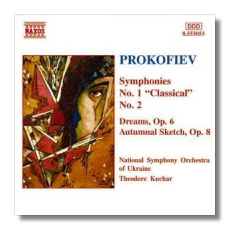
The Internet's Premier Classical Music Source
Related Links
- Prokofieff Reviews
- Latest Reviews
- More Reviews
-
By Composer
-
Collections
DVD & Blu-ray
Books
Concert Reviews
Articles/Interviews
Software
Audio
Search Amazon
Recommended Links
Site News
 CD Review
CD Review
Serge Prokofieff

Symphonies #1 & 2
- Symphony #1 in D Major "Classical", Op. 25 (1917)
- Symphony #2 in D minor, Op. 40 (1925)
- "Dreams" Op. 6 (Symphonic Tableau)
- Autumnal Sketch, Op. 8
National Symphony Orchestra of Ukraine/Theodore Kuchar
Naxos 8.553053 DDD 72:58
Summary for the Busy Executive: Heavy first, brilliant second.
Naxos has issued a complete set of Prokofieff symphonies with Kuchar and his Ukrainians. I will not review all of them, since I feel that you can do better with individual Fifths if you don't have it, and if you do, there's little point, other than curiosity or collector's mania, in seeking out Kuchar's. Kuchar does a good job with it, but others do as well or better. In this economy, we would all do well to exercise a little thrift.
Volume 1 starts with two very early orchestral works, Dreams and Autumnal Sketch, written before the composer had reached 20. According to Prokofieff himself, Dreams is tinged with the influence of Scriabin and Autumn takes off from Rachmaninoff, particularly Isle of the Dead. Critics didn't particularly care for them, mainly because they sounded too conventional. Prokofieff quotes one of them accusing him of having composed them in his sleep. Certainly it sounds nothing like the Prokofieff we expect. It shows at least some of his roots, and I think both he and the critics too harsh, at least in the case of the Sketch, which could do with an occasional revival – dark, broodingly Russian. The assurance and technique and ease of expression surprise me in someone so young. However, his future direction lay in other works around this time: the first piano concerto (1911) and Sarcasms (1911-14) among them.
One of Prokofieff's composition teachers, Nicolai Tcherepnin, got him interested in Haydn and thus inspired him to write a modern symphony using classical devices – the so-called "Classical" Symphony, written in 1916, two years before Stravinsky's first essays in neoclassicism. Prokofiev wrote one of his first hits as well as a masterpiece, although many people have trouble recognizing a masterpiece when it doesn't pull long faces and grimace.
You can do a lot better than Kuchar in this work. My favorite reading is Bernstein's with the NY Phil, light and mercurial. Kuchar falls down immediately in the first movement by adapting ponderous tempos, painfully obvious in the second subject group. The orchestra sounds fine, just loggy, as if they sat around after a heavy meal. The gavotte has little joy or swagger in it. The finale reminds me of a soda gone flat.
The Symphony #2 has had a troubled reception. In two complex movements, a long sonata and a twice-as-long variation set, it has never garnered critical champions, as far as I can tell. Everybody I've read thinks it a problematic work. It dissatisfied even Prokofieff, who planned a revision but died before he could get going. He blamed the symphony's failure on its extreme dissonance and on its complex architecture and counterpoint. However, one can find many more successful scores as dissonant and more contrapuntal. To me, the fault lies not with the architecture, but with the rhetorical plan, mainly that of the first movement. The score belongs very much to its time and place, Paris in the Twenties. In the opening, you hear echoes of Stravinsky's earlier Le sacre as well as the intense dissonance of Honegger, Milhaud, and Bartók's Miraculous Mandarin. It's exciting for the first few minutes. However, unlike, say, the Bartók, it never lets up, not even in its second thematic group. In all its twelve-plus minutes, it never takes a breath, and many wind up feeling like the sufferer in the old Anacin commercials, with hammer beating the anvil inside one's head.
We finally get a respite with the quiet theme, more Russian melancholy, of the second movement – again, a set of fantastical variations. Here, we also get variety in color, texture, rhythm, and mood. Indeed, it reminds me of Prokofieff's ballet scores. The penultimate variation ramps things up dynamically until we arrive at the last variation, another poundfest (heavy metal sounds comparatively tame), which mercifully dissipates shortly before its close, and we head back to a restatement of the quiet, lyrical theme. This is actually one of my favorite Prokofieff symphonic movements. It could easily stand alone in concert.
As disappointing as I found Kuchar's "Classical" Symphony, I think he does a wonderful job in the second – indeed, the best recorded performance I know (my previous favorite, Järvi on Chandos). The textures of the first movement don't gum up and he manages to impart a terrific sense of pace, although the composer ultimately louses him up. I recommend the disc for the Second and for the Autumnal Sketch. The sound is quite good.
Copyright © 2011, Steve Schwartz.





















